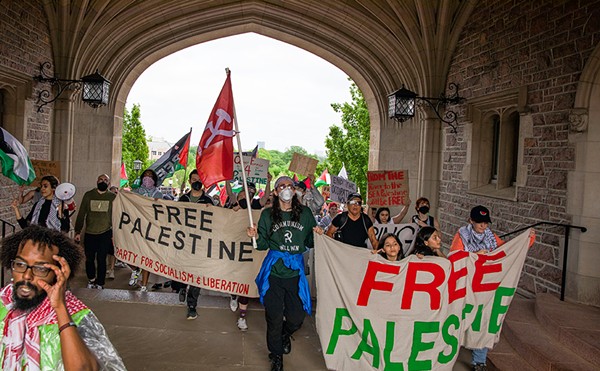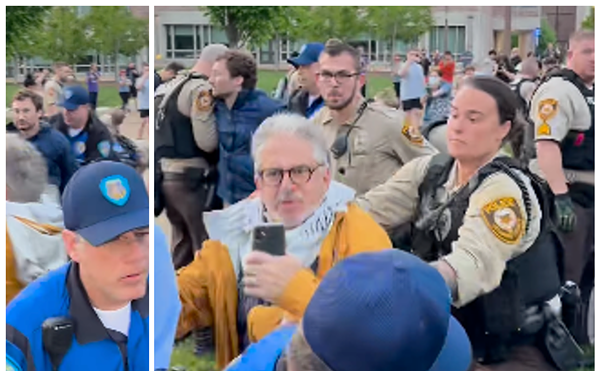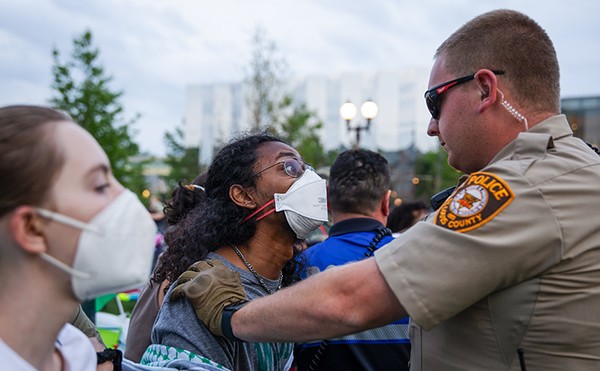Three decades later, the 43-year-old Dickerson has embraced her ancestry. The daughter of a full-blooded Kiowa Indian woman from Oklahoma and an Italian man from St. Louis, Dickerson spends her days curing animal hides with cow brains — a natural way of tanning leather — and crafting ornate moccasins and jewelry out of her south-city home. When her fingers and eyes grow tired, Dickerson pushes aside ancient traditions and logs on to her Web site, www.kiowakat.com.
Originally designed to market her handiwork, the site now serves as Dickerson's main tool for exposing people she believes are masquerading as Indians. These frauds, says Dickerson, distort the true heritage of Native Americans and rob them of what little income they can generate by selling craftwork and participating in demonstrations. In 1990 the U.S. Congress passed the Indian Arts and Crafts Act, a truth-in-advertising law that makes it illegal to sell handiwork that falsely suggests it is Indian-produced.
"Are you dealing with a native or a wannabe?" Dickerson warns on her site. "This is an attempt to stop the cons, deceit and bad information from ruining what culture we have left."
Last year Dickerson formed the St. Louis American Indian Consortium, a group of Native Americans seeking to monitor who is — and who isn't — a bona fide Indian. Now, after months of planning, the consortium is on the warpath against rival Indian groups that it claims are full of imposters.
"These fake groups have seen Dances with Wolves one too many times," says John White Antelope, a founding member of the consortium and member of the Arapaho Indian tribe. "They only associate the romantic and spiritual with being a Native American. They think we're these mystical creatures. They don't see my nine-to-five job."
Public enemy number one, says White Antelope, is the Thunderbird Society, a St. Charles-based organization that specializes in the Indian re-enactments held at Cahokia Mounds and other area institutions. The Thunderbirds solicit applicants online and do not require that members prove their Native American ancestry before joining. Members of the St. Louis American Indian Consortium, however, carry identity cards tying them to one of the 562 tribes officially recognized by the federal Bureau of Indian Affairs.
Different tribes have varying standards for membership. The Arapaho tribe, for example, requires a "blood quantum" of at least three-eighths Arapaho blood, while the Cherokee accept anyone who can prove a relationship with the tribe, even with bloodlines as low as one-one thousandth.
"If they called themselves hobbyists, I wouldn't have a problem," says White Antelope. "But they try to pass themselves off as real Indians. In my mind they're perpetuating fraud."
Last week Dickerson's consortium scored its biggest victory to date when it convinced officials at Fort Leonard Wood to stop the Thunderbird Society from participating in its American Indian Day festival, slated for mid-November. But Mark Pashia, an elder with the Thunderbird Society, likens Dickerson's tactics to an old-fashioned Indian ambush and suggests the consortium is more interested in economic gain than in preserving Indian culture.
"What we have here," says Pashia, "is a group of card-carrying Native Americans who think the Thunderbird Society interferes with their ability to make money. It's as simple as that."
Last week, in response to the consortium's allegations, Pashia changed the opening page of the Thunderbird's Web site to level some charges of his own against Dickerson. Pashia questions why Dickerson has yet to register her group with the Missouri Secretary of State's office. He further alleges that Dickerson's consortium demands higher fees for Indian dances and demonstrations than those charged by the Thunderbirds.
"Where's their money going?" asks Pashia. "They claim we make all this money, but we charge just nominal fees for events. Our annual income is less than $7,000, with much of that going to clothes and food we buy for the Lakota tribe of South Dakota."
Lora Garrett, treasurer of the Thunderbird Society, asserts that Dickerson and other members of the consortium use their bloodlines to bully other Native Americans. Like Pashia, Garrett says she's unable to prove her native identity because her Cherokee ancestors broke off from the original tribe. But, insists Garrett, that doesn't make her — or the Thunderbirds — lesser Indians.
"We're here for the same reasons she is," says Garrett. "We're trying to retain the culture, language and traditions of Native Americans. So what if we don't have cards? What matters most is where your heart is."
Last year Dickerson met with Bill Iseminger, assistant site manager at Cahokia Mounds, and urged that the site also prohibit the Thunderbird Society from participating in Indian ceremonies. Iseminger says he's sympathetic to Dickerson's concerns but maintains that the small number of Native Americans in the region makes it difficult to hold events without the help of "enthusiasts" with questionable Indian lineage.
The U.S. Census Bureau puts the number of people with American Indian or Alaska Native blood in the St. Louis metro area at around 18,000, or less than 1 percent of the overall population. But Dickerson contends that the number of people enrolled with federally recognized tribes is far fewer — more like a couple hundred area residents.
"A few years ago we had to cancel an Indian performing-arts series because we couldn't find enough Illinois-based Native Americans to receive a grant from the state," says Iseminger. "With each generation, those bloodlines continue to get thinner. It's tough to say who is and who isn't an Indian."
Dawn Jordan, a social advocate who helps other Native Americans secure jobs and education in the region, says the finger-pointing between warring Indian groups has grown increasingly hostile since the American Indian Center shuttered its doors last winter. For twenty years the south St. Louis center served as the official voice and watchdog for Indian affairs in and around the city.
Jordan hopes Dickerson's consortium can pick up where the Indian center left off and restore the reputation of the region's Native Americans.
"Last year I attended a festival at Cahokia Mounds. It was so terrible," Jordan recalls. "They were selling rubber tomahawks and those headbands that look like you have an arrow shot through your head. I was appalled! If [Dickerson] and her group want to step up to the plate and go after these people, I say more power to her."
But others — including 82-year-old Dolores Santha — think Dickerson has gone too far. For the past 30 years, Santha has made a small income telling Indian stories to schoolchildren and prison inmates under the name Grandma Coyote. Last month, she says, she was shocked to discover that Dickerson and her allies sent letters to Cahokia Mounds and other organizations claiming that Santha altered her 1929 birth certificate by changing her race from "white" to "red."
"Yee gads!" exclaims Santha. "What do they want me to do? Disown my parents? My father was a Comanche who fought in the all-Indian brigade in World War I. My mother was from the Seneca tribe."
Santha says she heard rumors that someone was besmirching her name but didn't know who to blame — until now. That the accusations are coming from other Indians, says Santha, makes the allegations even worse.
"That's probably why we were defeated by the Europeans," she says. "We quarrel among ourselves something terrible."





